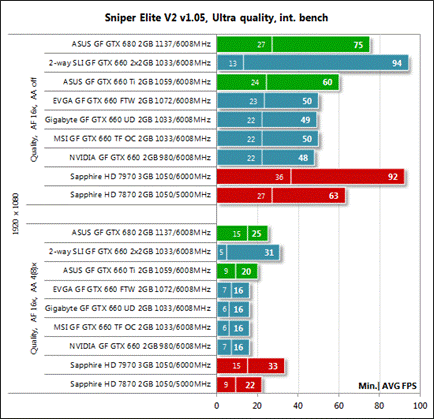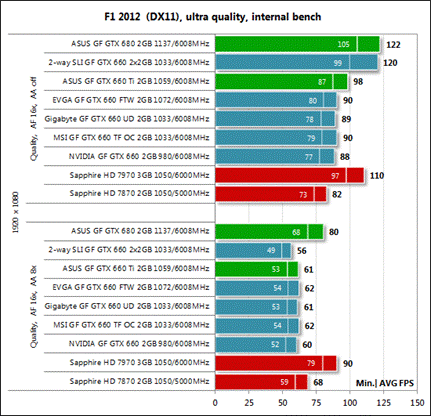Performance
3DMark
2011
As expected, the first GeForce GTX 660
products don’t have much difference in performance. They are 4 to 5% more
powerful than the original card. Meanwhile, the ASUS GeForce GTX 660 Ti is 11
to 19% more advanced among the three models when the Sapphire Radeon HD 7870
can be just a challenge in the Extreme settings.

Tested
by 3D Mark 2011
The SLI GeForce GTX 660 couple (Gigabyte +
MSI) seems working satisfyingly here to the test. Its efficiency rises up to 74%
at the Performance settings. At the Extreme settings this couple is 22% faster,
resulting in 90% efficiency. This figure is very impressive in term of that
these two GeForce GTX 660 models are presently cheaper than one single GeForce
GTX 680.
Metro
2033: The Last Refuge

Tested
by Metro 2003
The Metro 2033’s resource consumption
indicates no difference between the pre-overclocked GeForce GTX 660 and the source
sample from NVidia. The GeForce GTX 660 Ti, which is a bit prier, isn’t much different.
But the two GeForce GTX 660 products in SLI mode achieved a 90% performance and
a 40% advantage over the GeForce GTX 680. We should also consider the higher
speed of the AMD-based products in this test.
Total War: SHOGUN 2 – Fall of the Samurai

Tested
by Total War
The four GeForce GTX 660 models offer
similar performance in Total War: SHOGUN 2 – Fall of the Samurai. Opposite
to Metro 2033, the GeForce GTX 660 Ti created bigger advantage while the
GeForce GTX 680 and the Radeon HD 7970 are the strongest single-GPU cards during
the testing process. The SLI couple made of two GeForce GTX 660 cards is once
impressive, beating the single cards by 85-90% and the GeForce GTX 680 by around
27%.
Crysis 2

Tested
by Crysis 2
The three first-generation GeForce GTX 660
models and the ASUS GeForce GTX 660 Ti have the lowest frame rate whereas the source
NVidia GeForce GTX 660 is more powerful in this respect. The GTX 660 couple enhances
the average frame rate by 83-84%, but its bottom speed is still as low as of
the single cards. The GeForce and Radeon products sharing the same rank are
comparable together in the test.
Battlefield 3

Tested
by Battlefield 3
In this game, the results are similar to
those from previous tests.
Sniper Elite V2 Benchmark

Tested
by Sniper Elite V2 Benchmark
The AMD products are superior in this test
whereas the four GeForce GTX 660 models don’t differ at all. The GeForce GTX
660 couple is good, regarding average frame rate (90% higher in comparison with
the single card) but fails when considering bottom speed. To tell the truth,
this benchmark had some problems, especially in the high-quality graphics mode featuring
antialiasing.
Sleeping Dogs

Tested
by Sleeping Dogs
The four GeForce GTX 660 models also share
pretty similar results in Sleeping Dogs. And all of them are lower than the
Radeon HD 7870. The GeForce GTX 660 Ti is 13-19% higher than the GTX products,
depending on the graphics quality settings, and there’s the same gap between it
and the GeForce GTX 680 which is faster. The GeForce GTX 660 couple is the
fastest solution once again. Its bottom speed is also okay, unlike in the earlier
tests.
F1 2012

Tested
by F1 2012
F1 2012 is this test’s only game in
which the 2-way GeForce GTX 660 SLI couple doesn’t work really well. With
antialiasing disabled, its performance increase is so small that the two GTX
660s cannot beat the single GeForce GTX 680 though they had easily done that
before. Because of 8x MSAA enabled, the SLI mode cannot be activated, making
the SLI couple is quite slower, compared to the single cards.
Hitman: Absolution

Tested
by Hitman: Absolution
The four GeForce GTX 660 models and the GTX
660 Ti share the same performance level in Hitman: Absolution and out
of them, the Radeon HD 7870 does the best job. The SLI couple is very fast: 96%
faster than the single cards and 30% faster than the GeForce GTX 680. Though, it
has problem with the bottom speed in the high-quality graphics mode. Pitifully,
that’s a popular problem among multi-GPU solutions from both NVidia and AMD.
Summary Graphs
First, we want to remind you that eight of
the nine graphics cards in this review has been pre-overclocked in the factory.
The first diagram compares the EVGA GeForce GTX 660 FTW Signature 2 (the
fastest among the three GeForce GTX 660 models) with the ASUS GeForce GTX 660
Ti DirectCU II TOP:

EVGA
and ASUS GeForce GTX 660 Ti
Replying on the graphics quality mode, the
EVGA is 0 to 20% lower than the ASUS. The average difference throughout all of the
tests is 13% and 7% with antialiasing disabled and enabled. This was
predictable.
As we saw via our tests, the source cards,
which were pre-overclocked from EVGA, Gigabyte and MSI are all faster than the original
model from Nvidia, but we still want to show you the difference between the
fastest EVGA GeForce GTX 660 FTW Signature 2 and the original GTX 660:

EVGA
GeForce GTX 660 and the source GTX 660
Therefore, the overclocking process in
factory results in a 3-4% improvement in speed. Sadly, the manufacturers don’t overclock
the graphics memory which, throughout these tests, could create more
possibilities. That will ensure higher speed at high graphics quality configurations
with antialiasing enabled.
Following, we would like to test the
benefits of using two GeForce GTX 660 cards in SLI mode:

The
GeForce GTX 660 couple in SLI mode
Aside from F1 2012, the multi-GPU
technology performs well, ensuring a enhancement, in performance, of 83-91% in comparison
with the single card. On the other hand, we must admit some problems relating
bottom speed in most games.
And now is the last graph comparing the GeForce
GTX 660 couple with a single GeForce GTX 680:

The
GeForce GTX 660 couple and GeForce GTX 680
Buying two GeForce GTX 660 cards instead of
one pricy GeForce GTX 680 is rational because this SLI couple is averagely 26-28%
faster through games. Yet, the bottom speed should be born in mind.
Conclusion
The GeForce GTX 660 products from EVGA,
Gigabyte and MSI seem alike. We are unable to state who either win or lose
among them. As pre-overclocked, they feature similar performance, winning over
the source GeForce GTX 660 by 4-5%. The MSI GeForce GTX 660 Twin Frozr III appears
similar to the Gigabyte GeForce GTX 660 Ultra Durable with reference to GPU
temperature whilst the hotter EVGA GeForce GTX 660 FTW Signature 2’s original
cooler does a good job, especially since the EVGA has the peak GPU clock rate.
When their fan settings are at default, they produce the same noise level, even
when subjectively considered. In addition, there are the original PCBs plus
some features, the same amount and clock rate, the same overclocking potential,
and few accessories (especially for Gigabyte’s products). Plus, they share
similar cost; hence we really can’t pick out the best of the three that are
EVGA GeForce GTX 660 FTW Signature 2, Gigabyte GeForce GTX 660 Ultra Durable
and MSI GeForce GTX 660 Twin Frozr III. The decision is yours!